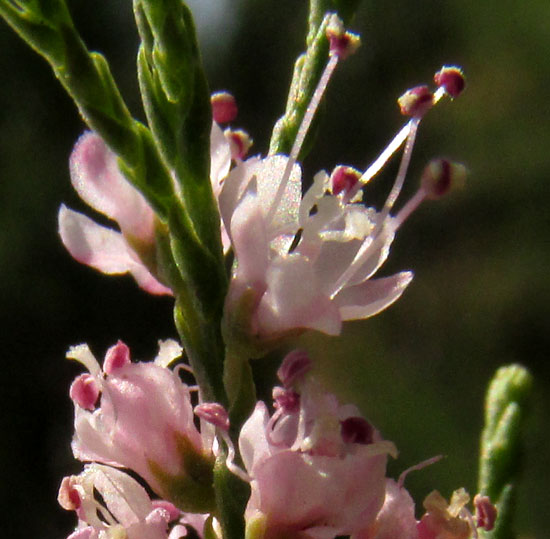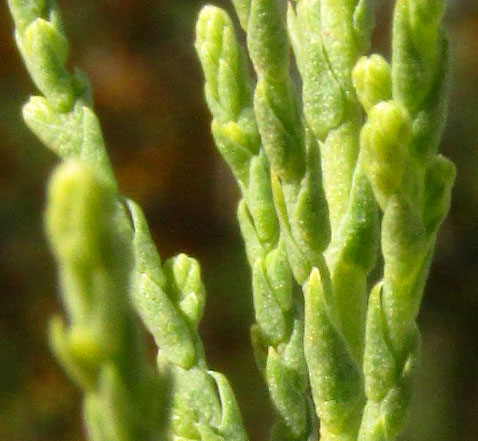Excerpts from Jim Conrad's
Naturalist Newsletter
from the April 19, 2018 Newsletter with notes taken two weeks earlier during a camping trip in Amistad National Recreation Area nine miles northwest of Del Rio, western Texas, on the border with Mexico; elevation ~369m (~1180ft), N29.465°, W100.964°
TAMARISK FLOWERING
Amistad Reservoir's water level fluctuates wildly, depending on rains upstream, rising precipitously when the remains of a hurricane pass through. In a certain spot sometimes deeply submerged and other times high and dry, much-branched, wispy-looking, woody shrubs or small trees turned up forming a thicket nearly devoid of all other plants. They bore dense heads of tiny, pinkish flowers, which showed up nicely in morning sunshine, as shown below:

The flowers arranged themselves in numerous spike-like racemes at the ends of branches, almost looking like willow catkins, as seen below:

The blossoms themselves were attractive but not particularly unusual or distinctive looking, as you can confirm below:

However, in the above close-up, look at the green stem arising above the flowers. Instead of with normal leaves, the stem bears only green, overlapping scales, similar to what we see on junipers and cedars, though junipers and cedars are gymnosperms and flowers like these occur only on angiosperms. A closer look at the juniper-like stems with their scale-like leaves is shown below:

So, this is this plant's big novelty -- that it bears typical angiosperm blossoms on a body that looks like it belongs to a gymnosperm
*Our plant is a species of tamarisk, genus Tamarix, in the Tamarisk Family, the Tamaricaceae, whose species all are native to the Mediterranean region and Africa to eastern Asia. Therefore, our lakeside shrubs are invasive. In fact, the TexasInvasives.Org website lists Tamarix ramosissima -- there called Salt Cedar -- as a noxious weed, and the species is further listed in the Invasive Plant Atlas of the US.
The TexasInvasives.Org web page for tamarisk is unsparing about the species' disagreeable features. Tamarisks grow long tap roots that intercept deep water tables; they degrade native wildlife habitat by outcompeting and replacing native plant species; they increase the frequency, intensity and effect of fires and floods, and; they provide little food for native wildlife species. To make matters worse, each bush can produce thousands of minuscule, hair-tufted seeds that can be dispersed by both wind and water.
The TexasInvasives.Org page profiles Tamarix ramosissima, and as far as I can see our plants look exactly like the Tamarix ramosissima shown on their page. However, I'm not at all sure that our plant is Tamarix ramosissima, and maybe nowadays nobody can be sure. That's because Tamarix taxonomy is in a mess, with little agreement among specialists as to what's a species and what's just a variation of one or a few variable species, plus often hybridization between species occurs. The online Flora of North America currently lists eight species that have become naturalized in North America ("gone wild"), with several other species occasionally found in gardens.
All that being said, that day when I came upon my first tamarisk thicket, I was glad to meet the plant. With global warming and the expected mass extinction of many species, it may turn out that aggressive, super-adaptable plants like tamarisk will be the only survivors in some or many environments. Nowadays I find myself admiring vigor and staying-power wherever I find it.